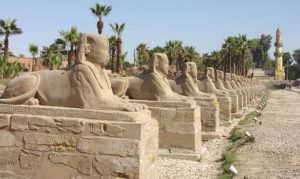Sphinx Road in Luxor

In ancient times, the Sphinx Avenue was known as Ipet-isut. The Sphinx Road is a 3 km-long avenue of sphinxes connecting Luxor Temple with the southern end of the sprawling Karnak Temple Complex to the north. Bordered on both sides by the majestic sphinxes, the avenue was used to lead all the way to the Temple of Karnak. It was dedicated to the Theban Triad of Amen, Mut and Khonsu. Archeologists believed that the avenue covered an area of 3 km in the ancient times with about two thousand Sphinxes. The avenue was first erected by Amenhotep III and later re-constructed by King Nectanebo I in the 4th century. This king replaced the former ram-headed sphinxes with his own head. An archeological mission of the Egyptian Higher Council of Antiquities (EHCA) discovered remains of the Avenue of the Sphinxes on the ancient road connecting temples at Luxor and Karnak. These remains included four headless sandstone sphinx statues that belonged to King Nectanebo I (Nakhtnebef) of Sebennytos (modern Sammanud), the founder of the Thirteenth Dynasty (363-380 BC). They had the body of a lion with the head of Nectanebo I. These finds were discovered under the remains of a police station. Other twenty Sphinx statues were discovered at the site in 2007. Because there are still some places in Luxor where some remains can be traced, the EHCA and the Higher Council of Luxor are joining together to excavate and discover the monuments and sphinx statues buried in the area between the Luxor and Karnak temples.




